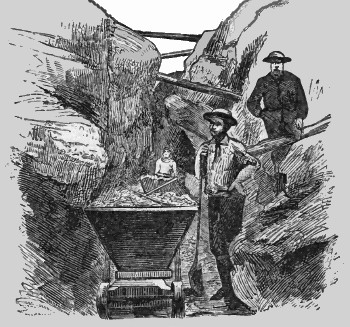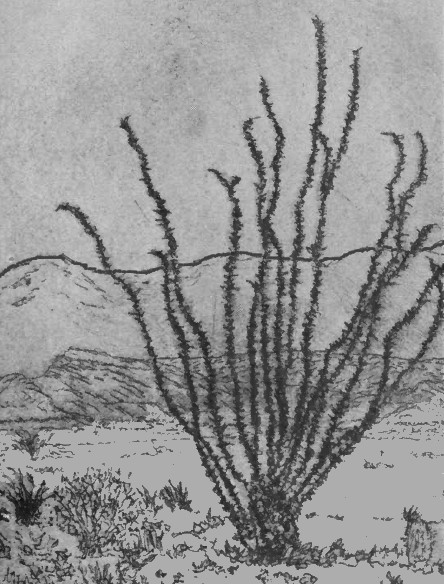Exploring parties sent out by the Government, particularly those along the southern part of what is now Arizona, gave some attention in a casual way to the mineral resources of the country, and these reports reaching San Francisco, probably much magnified, gave rise to the organization of the first exploring party sent into what is now Arizona. Some time in the latter part of the year 1854, a company was formed by Major B. Allen, J. D. Wilson, William Blanding, A. S. Wright, and others, which was known as the Arizona Mining & Trading Company, under the direction of E. E. Dunbar. The expedition was outfitted in Los Angeles in October, 1854, and started, twenty men strong, for Fort Yuma. The names of these men, as far as is at present known, were E. E. Dunbar, McElroy, F. Eondstadt, P. Brady, G. Kibbers, George Williams, Joe Yancy, Dr. Webster, Porter, Charles Hayward, Bendel, Cook, and one other.
Taking the road by Tinaja Alta, they heard of the Ajo copper mines, about 90 miles south of east of Yuma. There they left six men to hold possession as best they could. The remainder continued to prospect the Arizona mountains for the celebrated silver mine known as the Planchas de la Plata, that had been abandoned by the Mexicans, of which it is stated, in Ward's Mexico, that a piece of native silver of 2700 pounds had been taken out by the Spaniards. After several months of continued search, this mine was discovered. They found first a piece of pure silver of about four ounces and a few days thereafter a piece of nineteen pounds was taken out of old shallow diggings, overgrown by stout oak trees. About this time the party at the Ajo copper mine was attacked early in the morning by a company of Mexican soldiers, headed by the Prefect and other authorities, who demanded the delivery of the mine, as owned by the Mexicans.
The boundary line under the Gadsden purchase had not yet been established, and the Mexican authorities threatened to take the mine by force if it was not surrendered within two hours. Mr.Hayward's spirited answer to them was: "We don't think of surrendering ; if you want to fight, let us begin before the sun gets hot," and this settled the question. The troops retired to the Presidio del Altar, Sonora, just in time to receive the news of the discovery of the long lost Planchas de la Plata by the rest of the American party. The Mexicans immediately ordered the Americans to leave the country, and they, being well aware that they were on Mexican territory, thought it prudent to comply. The Ajo mine was worked continuously from 1855, and the first shipment from it was of exceedingly rich ore, which was made to San Francisco in 1856, by the Arizona Mining and Trading Company. In 1856 a Mexican from San Francisco organized an outfit to work the mines near Tucson. He first worked a copper mine about thirty-five miles west from there, and then a silver mine near San Xavier del Bac. The entire party, after much delay, arrived at Yuma, and was afterwards lost with man and beast, in the territory between Maricopa Wells and the copper mine. Only one person, a man by the name of Cook, escaped. This crippled the enterprise so that it came to a standstill.
About this time, Mr. Herman Ehrenberg, whose name is linked with the early history of Arizona, and who had been, for some time, prospecting along the Gila and in Sonora, formed in New York the Sonora Exploring and Mining Company, of which Samuel Colt, of Hartford, William T. Coleman, Chas. D. Poston, and Major Hartley were directors. This company, of which Major Heintzelman was president, is said to have received $100,000 from the Texas and Pacific Railroad Company for the opening up of mines in Arizona. The representatives of the company arrived, with Mr. Poston, as manager, Ehrenberg and Bonkow, as mining engineers, in Arizona, in 1857, and took up headquarters in the deserted town of Tubac, which had been evacuated by the Mexican troops, leaving the quarters in a fair state of preservation, minus doors and windows, which they hauled away. The headquarters of the mining company, in the autumn of 1856, were made comfortable, a store of provisions was laid in for the winter, and the exploration of the company for mines was ready to begin. "The mines in the Santa Eita mountains had," says Col. Poston, ''been previously worked by the Spaniards and Mexicans, as was evident by the ruins of arrastres and smelters.
Gold could be washed on the mountain sides, and silver ore veins could be traced by the discolored grass.When it became known in Mexico that an American company had arrived in Tubac, Mexicans came in great numbers to find employment, and skilled miners were obtained at from fifteen to twenty-five dollars a month and rations. Flour, beef, beans, sugar, barley, com and vegetables, were imported from Sonora at moderate prices. Many Mexicans, formerly soldiers of the Presidio of Tubac, had holdings of land in the valley and returned with their families to cultivate their ''milpas." By the first of January following, an unofficial census of the valley of the Santa Cruz, in the vicinity of Tubac, showed a population of about a thousand souls. Col. Poston says: "We had no law but love, and no occupation but labor. No government, no taxes, no public debt, no politics. It was a community in a perfect state of nature. As 'syndic' under New Mexico, I opened a book of records, performed the marriage ceremony, baptized children and granted divorces. It is astonishing how rapidly the development of mines increases commerce. We had scarcely commenced to make silver bars,—'current with the merchant'—when the plaza of Tubac presented a picturesque scene of primitive commerce. Pack trains arrived from Mexico, loaded with all kinds of provisions. The rule was to purchase everything they brought, whether we wanted it or not. They were quite willing to take in exchange silver bars or American merchandise. Sometimes they preferred American merchandise. Whether they paid duties in Mexico was none of our business. We were essentially free traders. The ore in the Santa Rita Mountains proved to be too low grade to be profitably worked at that time, so the explorers turned their attention to the west side of the Santa Cruz River, and soon a vein of silver copper glance, called by the Mexicans ''petanque" was discovered that yielded from the grass roots seven thousand dollars a ton. This mine was afterwards named in honor of the president of the company, "Heintzelman," which, in German mining lore, is said to be the name of the genius who presides over mines.
The products of the mine, after smelting, which contained about fifty per cent of silver, were shipped to San Francisco, via Guaymas, where the silver was sold at from 125 to 132 cents per ounce for the Asiatic market. Silver bullion being rather too weighty for purposes of exchange, the company adopted the Mexican system of ''boletas.' Engravings were made in New York and paper money printed on pasteboard about two inches by three, in small denominations, twelve and one-half cents, twenty-five cents, fifty cents, one dollar, five dollars, and ten dollars. Each boleta had a picture by which the illiterate could ascertain its denomination, viz.: twelve and one-half cents a pig; twenty-five cents, a calf; fifty cents, a rooster; one dollar, a horse ; five dollars, a bull ; ten dollars, a lion. With these boletas the hands were paid off every Saturday, and they were taken as currency at the stores, and among the merchants in the country and in Mexico. When a run of silver was made, anyone holding tickets could have them redeemed in silver bars, or in exchange on San Francisco. This primitive system of flat money had an excellent effect.
Everybody holding these boletas was interested in the success of the mines, and the entire community was dependent for its prosperity upon that of the company. They were all redeemed and retired from circulation. In the autumn of 1857 a detachment of the First Dragoons arrived in the Santa Cruz Valley, and established Fort Buchanan. The officers were Colonel Blake, Major Stein and Captain Ewell. Coincident with the arrival of the military on the Santa Cruz was the arrival of a citizens' train of wagons laden with supplies — twelve wagons with twelve mules each — belonging to Santiago Hubbell, of New Mexico. These wagons took back a return freight of ores from the Heintzelman mine to the steamboat landing at Kansas City, for which they were paid twelve and a half cents a pound. The ores were in rawhide bags, and a ton to the wagon. This was the first shipment of ore from this part of what is now Arizona, and was a very long haul for mule teams. On their arrival in the States, they were distributed to different cities for examination and assay, and gave Arizona its first reputation as a producer of minerals. The average was $1500 per ton in silver, besides a good deal of copper ore. The first mining machinery brought into Arizona was by this company.
Sylvester Mowry, in his address before the Geographical Society, in 1859, said: ''The Heintzelman Mine—so called after the president of the company—bids fair to become more famous than any of the great mines of Old Mexico. From a late letter it is claimed that the ores thus far smelted yield the astonishing average of $950 per ton. I saw this mine in September of last year. About two hundred tons of the ore had already been extracted, and the yield from one small furnace was about one thousand ounces per week. At a cost of $39,000 the company have brought from. San Francisco and erected amalgamating works, from which they expect to obtain $3,000 per day—a million a year. This mine has the most extraordinary reputation throughout Sonora. I found, in traveling through the state, that almost every shop keeper knew the value of the ore. It was obtained from the miners, who had stolen and sold or exchanged it for goods."
The reduction works of the Heintzelman mine were located on the Arivaca ranch, eight miles distant from the mine, and connected with it by an excellent road. The process used was the European barrel amalgamation for argentiferous copper ores, and was introduced by Mr. Kustel, a German metallurgist, about the year 1859. About one and a half tons per day was reduced. Six dry stamps, a steam arrastra, one reverberatory roasting furnace, four barrels, a retort, and one refining furnace, together with a ten horse-power engine, constituted the works. This was the first time where the barrel process for the treatment of argentiferous ores was used in the United States, and, being experimental, was far from perfect. Lieutenant Mowry, in his "Arizona and Sonora," page 167, says: ''From the results obtained in 1859 on 160 tons of amalgamated ore, it appears that about $24,000 worth of silver was produced. The loss of quicksilver equaled one pound (one dollar) for every forty dollars of silver extracted. The consumption of copper was 1480 pounds ; of salt, 32,000 pounds, and of wood, 300 cords. The production of silver at the Heintzelman mine is estimated at over $100,000 (not including large amounts of ore stolen and worked in Sonora)." Besides these there were many other mines and prospects being worked in that vicinity. Tubac became one of the most prosperous towns in the territory, with a mixed population of four or five hundred, with handsome residences, storerooms, gardens and fields, and other evidences of civilized life.
Return
to The Arizona Page:
Arizona Gold Rush Mining History



